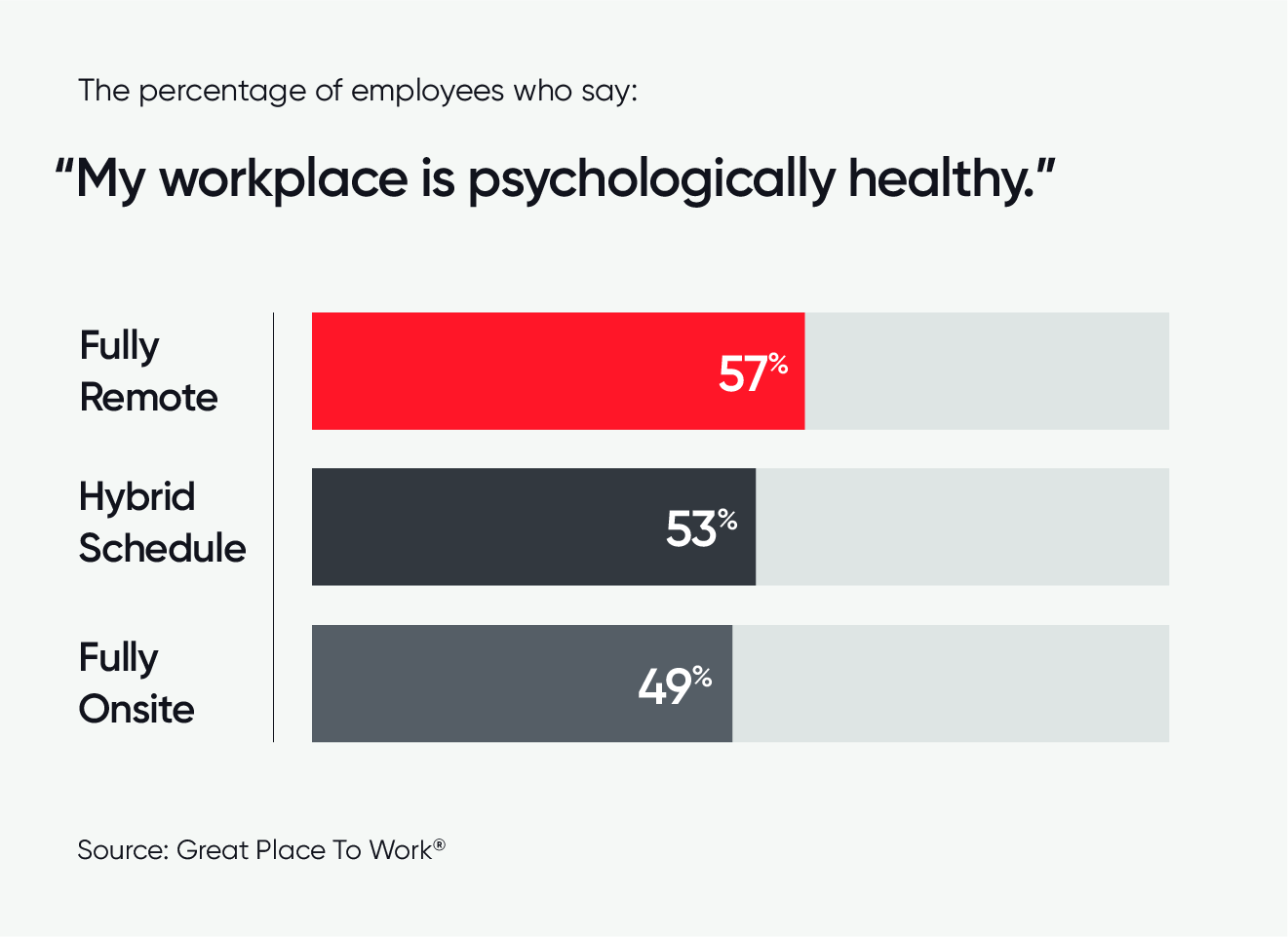Elements of Company Culture, Employee Experience, Employee Well-being, Remote & Hybrid Culture
Workplace flexibility is about providing the conditions for employees to thrive. And it’s only successful in great high-trust company cultures.
Unlimited time off. Flex hours. The ability to work whenever and wherever.
Not too long ago, these were unheard of in the working world. Typical employment meant being visible, at your desk or station, for eight hours a day, five days a week.
And then COVID came.
Flexibility in the workplace was already on the rise pre-pandemic, with forward-thinking, globalized organizations adopting non-traditional setups such as remote teams and flex schedules. But then lockdowns forced everyone to embrace workplace flexibility — whether they were ready or not.
And now, while some companies have returned to their old routines, other employers have decided to stay flexible for good.
What is workplace flexibility?
Workplace flexibility means providing the conditions for employees to thrive. Workplace flexibility embraces the idea that employees can be productive no matter when or where they perform their work. Rather than enforcing a rigid workplace environment or schedule, workplace flexibility acknowledges individual needs and supports better work-life balance and employee well-being.
Note that this is different from employee flexibility, which typically refers to how adaptable an employee is in the workplace. Workplace flexibility is also different from 'work-life balance' which pits work against life - as if work is an antonym to life. Workplace flexibility acknowledges that the two are more intertwined and fluid.
In a flexible workplace, management trusts employees to perform their work in a non-traditional structure, and provides the necessary resources and environment to empower employees to work in this way.
Trust is the key factor in flexible workplaces
Flexible work and remote work are most effective in high-trust cultures. In high-trust company cultures, employees feel safe to speak up, feel safe to fail, and feel trusted by their leaders to get their job done regardless of when and where they work.
This is something that Meg Newhouse, co-founder and CEO of consulting firm and Certified™ great workplace Inspirant Group, advocates.
Inspirant is a remote-first organization, with flex hours and unlimited PTO, and a focus on supporting employees so they can be successful both in and out of the workplace — whether that’s by letting them set their own personal goals in performance reviews or giving them the trust and freedom to take time off whenever they need.
“We’ve never felt like we needed to monitor where people are working or how they’re working or when they’re getting their work done,” says Meg. “People just fit the work into their day, just like they fit everything else into their schedule.”
Why is workplace flexibility important in today’s work environment?
Employees are demanding more workplace flexibility — and even leaving their current jobs in search of it. The Great Resignation has proven that employees are seeking greater purpose and flexibility in the workplace.
“You can’t advertise a job without saying it’s flexible and expect to get high quality applicants,” warns Meg. “Advertising a position as remote-first is what people are looking for.”
Workplace flexibility also bursts your talent pool wide open. When you’re no longer tied to only hiring people within commuting distance or who are always available Monday to Friday, nine-to-five, the world becomes your recruitment oyster.
Not only that, but companies that fail to adapt and adopt at least some sense of flexibility are going to fall behind as the global workforce continues to change.
“We’re in the midst of a workplace revolution and, as a result, employees are in the driver’s seat,” says Meg. “And with that comes a shift in how leaders need to show up.”
What are the advantages and disadvantages of workplace flexibility?
As with anything, there are pros and cons to a flexible workplace.
Advantages of workplace flexibility:
- Flexible work opens you to the best recruits, from anywhere. Once location and hours aren’t criteria, you’re more likely to build a diverse team of top talent.
- Psychological health.According to our 2022 survey of average U.S. workplaces, employees who work remote part-time or full-time report higher psychological health than employees fully onsite. In fact, 57% of fully remote employees report good psychological health compared to 49% of employees who work on site five days per week.
- Work-life In the same study, employees who work remotely were more satisfied with their work-life balance than those working onsite (63% vs. 57%).
- Employee engagement. When employees feel trusted and can have a healthy work-life balance, they’ll be more engaged, more productive, and less likely to quit. Remote or hybrid employees report more willingness to give extra on the job (60%) compared to employees fully onsite (53%).
- Business results. Despite many employers’ fears, switching to remote work during the pandemic did not hurt their bottom line. In fact, in many cases.

Disadvantages of workplace flexibilty:
- Employee perceptions of fair promotions. Companies with hybrid workplaces or that are 100% remote have a more difficult time creating fair promotions practices compared to workplaces with a fully on-site workforce. As our research revealed, remote employees are 6% less likely to believe promotions are fair at their workplace compared to employees who spend one to four days on-site or in the office.
- Connection to the bigger picture. Employees who work fully remote tend to feel less connected to the company mission and feel less like they make an impact. At the average U.S. workplace, 58% of remote employees feel they make a difference at work compared to 65% of on-site employees.
- While tools like Zoom, Teams, and Slack are great for keeping your team connected, there really is no substitute for face-to-face communication. And when employees are online at different times, it can be challenging to resolve urgent issues that pop up.
- Blurring of home and work. Despite the freedom that flexible work can bring, it’s very easy for employees to work longer hours at home, or to struggle with setting a schedule for themselves — a recipe for workplace burnout.
- Remote work can easily lead to feelings of social disconnection and loneliness, especially if it’s an employee’s first time working this way.
6 Examples of flexible working conditions
There are variations to flexible working arrangements, which can be mixed and matched based on your organization’s needs:
- Flexible scheduling. Employees can set their own hours, shifts, and break times, or could opt for a compressed workweek (i.e., working full-time in four days instead of five).
- Flexible hours. Employees can switch to part-time or cut hours when needed.
- Flexible location. Employees can choose to work from home, the office, or other location. Many high-trust workplaces enable their employees to work from any location in the world. Other companies allow their employees to work from a remote location as long as they are on the same time zone.
- Flexible (or unlimited) PTO. Employees are free to take time off when they need it, without having to worry about using up a limited vacation allotment.
- Flexible positions (job sharing). Two or more employees share a single role so that they can work part-time while the role is covered full-time.
- Cross-department secondments which let employees immerse themselves in a different area of the business for a temporary period without losing their “day job.” Focused on career development and exposure, Certified workplace Cox Enterprises calls these secondments “Cox Gigs.”
Cox Gigs builds collaboration across the company and help their people discover their passions and network with other teams. A software engineer might try her hand at social media marketing. A human resources manager might decide to give project management a try. Cox Gigs is just one way to empower employees to not only succeed in their career paths, but to chart new ones.
Offering any (or all) of these arrangements can significantly boost employee morale and overall company culture.
For example, at consulting firm QVest US, a flexible PTO policy proves to employees that management trusts them.
“Leadership understands that taking time off to recharge is important for our success and our well-being,” one employee said in the survey for our . “We are trusted and empowered to take time off when necessary, as long as we coordinate with our teams to ensure our projects will not be impacted.”
Another flexible workplace, hospitality-staffing platform Qwick, has just switched to a four-day workweek.
“[It’s] been life-changing for me,” commented an employee. “I feel like it is really helping me to achieve a better work-life balance and also meet important goals in my personal life.”
Flexible work arrangements can also include offering things like mental health days or offline days. For example, Forma, a life benefits platform, offers “Recharge Days,” and Front, a customer communication service, has a weekly company-wide “unreachable day.”
How to handle supervision in flexible workplaces
Micromanaging is the antithesis of flexible work. Meg Newhouse recommends managers meet at least weekly one-on-one with their employees, especially in a remote environment. However, she’s quick to point out, this isn’t about checking up on how they’re working, but rather checking in on how they’re doing..
“If you’re not in a traditional office where you could just stop by someone’s desk or bump into them in the kitchen, or jump out to a quick lunch, you have to be more intentional about these virtual check-ins,” she says.
And don’t even think about installing any remote tracking programs or requiring employees to have their video cameras turned on whenever they’re online.
“You’re not running a daycare,” adds Meg. “If they’re not delivering on time or if they’re not showing up when they say they’re going to be there, those are red flags you should address. But if you’ve got people delivering good quality work … there’s no reason for extreme oversight.”
How can you measure the success of a flexible work environment?
You just need to look at your business results, says Meg. If employees are unhappy, customers and clients will be equally unhappy, and your business overall will suffer.
That’s not a problem at Inspirant.
“Our revenue numbers are continually increasing, our profit margin looks good,” she says. “If you want to look at the bottom line, you can see the ROI of trusting your workforce.”
Beyond that, you’ll want to regularly check in with your employees — whether that’s in your one-to-one catch-ups or via pulse survey — to ensure your flexible work environment is meeting their needs. Do they have the tools they require? Do they feel supported by their manager? How is their employee well-being?
“There’s no work-life balance,” Meg explains. “It’s all life.”
Does your organization have a great flexible work environment?
Show employees, recruits, and customers why your company is a great workplace by getting Great Place To Work Certified™.














